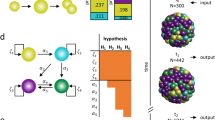Summary
The consistency of the frog blastula's fate map is produced, in part, because the progeny of blastomeres located in dfferent regions do not intermix with one another. We examined the cause for this restriction of intermixing in two types of cultures. In one type of culture, two groups of cells were excised from blastulae and stuck together; the movement of cells between the groups was monitored. Cells migrated more extensively between groups derived from the same region than between groups derived from different regions. In the other type of culture, a single cell was implanted into a group of cells that was excised from the blastula. The rate of division and the extent of migration of the implanted cell's clone were monitored. The implanted cell divided more rapidly among cells from its own region than among cells from a different region. Both experiments show that the restriction of intermixing that occurs between regions of the intact embryo also occurs in vitro. These results indicate that the restriction does not result secondarily from normal morphogenetic movements, which are absent from the explants, but probably from cellular interactions that limit the extent of cell migration. This limitation is correlated with a reduction in the rate of cell division.
Similar content being viewed by others
References
Abercrombie M (1946) Estimation of nuclcar populations from microtome sections. Anat Rec 94:239–247
Boterenbrood EC, Narraway JM, Hara K (1983) Duration of cleavage cycles and asymmetry in the direction of cleavage waves prior to gastrulation inXenopus laevis. Roux' Arch Dev Biol 192:216–221
Cardellini P (1988) Reversal of the dorsoventral polarity inXenopus laevis embryos by 180° rotation of the animal micromeres at the eight-cell stage. Dev Biol 128:428–434
Dale L, Slack JMW (1987) Fate map for the 32-cell stage ofXenopus laevis. Development 99:527–551
Feldman M (1955) Dissociation and reaggregation of embryonic cells ofTriturus alpestris. J Embryol Exp Morphol 3:251–255
Gurdon JB (1989) The localization of an inductive response. Development 105:27–33
Gurdon JB, Fairman S, Mohun TJ, Brennan S (1985) The activation of muscle-specific genes inXenopus development by an induction between animal and vegetal cells of a blastula. Cell 41:913–922
Hirose G, Jacobson M (1979) Clonal organization of the central nervous system of the frog. I. Clones stemming from individual blastomeres of the 16-cell and earlier stages. Dev Biol 71:191–202
Jacobson M (1983) Clonal organization of the central nervous system of the frog. III. Clones stemming from individual blastomeres of the 128-, 256-, and 512-cell stages. J Neurosci 3:1019–1038
Jacobson M, Klein SL (1985) Analysis of clonal restriction of cell mingling inXenopus. Phil Trans R Soc Lond B 312:57–65
Jones EA, Woodland HR (1987) The development of animal cap cells inXenopus: a measure of the start of animal cap competence to form mesoderm. Development 101:557–563
Keller RE (1975) Vital dye mapping of the gastrula and neurula ofXenopus laevis I. Prospective areas and morphogenetic movements of the superficial layer. Dev Biol 42:222–242
Keller RE (1976) Vital dye mapping of the gastrula and neurula ofXenopus laevis II. Prospective areas and morphogenetic movements of the deep layer. Dev Biol 51:118–137
Keller RE (1978) Time lapse cinemicrographic analysis of superficial cell behavior during and prior to gastrulation inXenopus laevis. J Morphol 157:223–248
Keller RE (1984) The cellular basis of gastrulation inXenopus laevis: Active, postinvolution convergence and extension by mediolateral interdigitation. Am Zool 24:589–603
Keller RE, Danilchik M (1988) Regional expression, pattern and timing of convergence and extension during gastrulation ofXenopus laevis. Development 103:193–209
Keller RE, Danilchik M, Gimlich R, Shih J (1985) The function and mechanism of convergent extension during gastrulation ofXenopus laevis. J Embryol Exp Morphol 89:185–200
Klein SL (1984) Studies on the interactions betweenXenopus blastomeres. Dissertation University of Utah
Klein SL (1987) The first cleavage furrow demarcates the dorsalventral axis inXenopus embryos. Dev Biol 120:299–304
Moody SA (1987a) Fates of the blastomeres of the 16-cell stageXenopus embryo. Dev Biol 119:560–587
Moody SA (1987b) Fates of the blastomeres of the 32-cell stageXenopus embryo. Dev Biol 122:300–319
Moody SA, Jacobson M (1983) Compartmental relationships between anuran primary spinal motoneurons and somitic muscle fibers that they first innervate. J Neurosci 3:1670–1682
Moscona A (1952) Cell suspensions from organ rudiments of chick embryos. Exp Cell Res 3:535–539
Moscona A (1956) Development of heterotypic combinations of dissociated embryonic chick cells. Proc Soc Exp Biol Med 92:410–416
Nakatsuji N, Johnson KE (1982) Cell locomotion in vitro byXenopus laevis gastrula mesodermal cells. Cell motility 2:149–161
Nakatsuji N, Johnson KE (1983) Conditioning of a culture substratum by the ectodermal layer promotes attachment and oriented locomotion by amphibian gastrula cells. J Cell Sci 59:43–60
Newport J, Kirschner M (1982) A major development transition in earlyXenopus embryos: I. Characterization and timing of cellular changes at the midblastula transition. Cell 30:675–686
Nieuwkoop PD (1969) The formation of the mesoderm in urodelean amphibians. I. Induction by the endoderm. Roux's Arch Dev Biol 162:341–373
O'Brochta DA, Bryant PJ (1985) A zone of non-proliferating cells at a lineage restriction boundary inDrosophila. Nature 313:138–141
Paleček J, Ubbels GA, Rzehak K (1978) Changes in the external and internal pigmentation pattern upon fertilization in the egg ofXenopus laevis. J Embryol Exp Morphol 45:203–214
Slack JMW (1983) From egg to embryo. Determinative events in early development. In: Barlow PW, Green PB, Wylie CC (eds) Developmental and cell biology, Ser 13. Cambridge University Press, Cambridge, England
Steinberg MS (1963) Reconstitution of tissues by dissociated cells. Science 141:401–408
Steinberg MS (1981) The adhesive specification of tissue self-organization. In: Connelly TG (ed) Morphogenesis and pattern formation. Raven Press, New York, pp 179–203
Townes PL, Holtfreter J (1955) Directed movements and selective adhesion of embryonic amphibian cells. J Exp Zool 128:53–120
Wetts R, Fraser SE (1989) Slow intermixing of cells during Xenopus embryogenesis contributes to the consistency of the blastomere fate map. Development 105:9–15
Author information
Authors and Affiliations
Rights and permissions
About this article
Cite this article
Klein, S.L., Jacobson, M. In vitro evidence that interactions betweenXenopus blastomeres restrict cell migration. Roux's Arch Dev Biol 199, 237–245 (1990). https://doi.org/10.1007/BF01682083
Received:
Accepted:
Issue Date:
DOI: https://doi.org/10.1007/BF01682083




